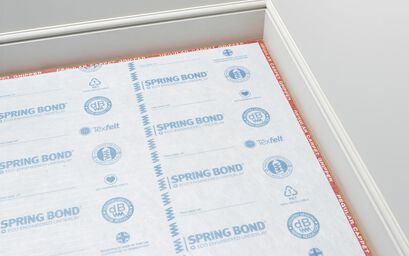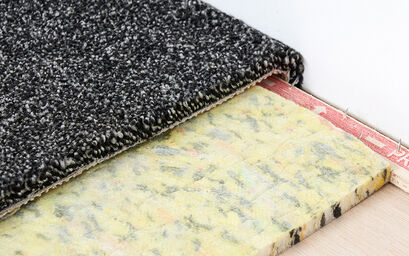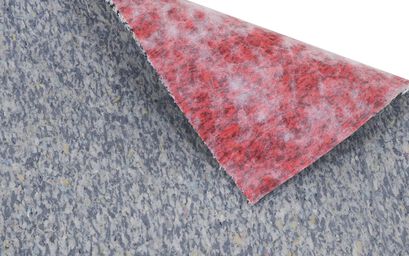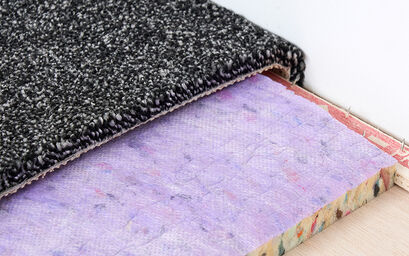Flooring
The ultimate guide to underlay
Underneath every type of flooring is the perfect, supportive underlay. Find out all you need to know about underlay and what to consider when choosing underlay for your flooring in my ultimate guide.
18th September 2023
Your underlay is an important purchase not to be forgotten once you’ve chosen your new flooring. You may have a few questions about why you need it, why it’s important and the different types, styles and thicknesses available. Read on to learn more about choosing the right underlay for you as I guide you through the many options available.
What is underlay?
Underlay describes the thin layer of material fitted over your subfloor and underneath your desired flooring to create a cushioning layer between the two. It can be made from a variety of materials including rubber, felt, fibre or foam and each have their own beneficial properties.
Why do you need underlay?
Underlay is fundamental to flooring and determines how your flooring feels, looks and wears. Without underlay, your flooring would be much less comfortable to walk on and would wear much faster.
The correct underlay lays the foundations for the longevity of your flooring and helps increase its lifespan by up to 50%. Sometimes the subfloor in which your flooring is going to be fitted over can be uneven. Underlay helps to rectify this and helps create a smooth and even surface for your flooring to be laid on. Underlay is also used if your flooring has a textile or latex backing.
A good quality underlay will also have noise reducing qualities and provide insulation too.
Here's one of our experts explaining some of the reasons why underlay is so important:
Benefits of underlay
Underlay has many benefits and will make sure that you get the most out of your new flooring.
Here are the main benefits of underlay:
Underlay will...
● Provide you with extra cushioning, making your carpet, wood or laminate flooring even more comfortable underfoot
● Help to insulate your room, retaining heat which can help to reduce your energy bills
● Help to reduce noise - ideal for family homes or those living in flats
● Help to prolong the life of a carpet by up to 50%
● Act as a shock absorber for carpets, allowing them to withstand more wear and tear
● Reduce air borne sound under laminate and wood flooring.
Poor quality underlay can lead to the risk of voiding your carpet warranty, but our carpet specialists are happy to help you determine which type of underlay will provide the best support for your carpet.
Considerations when purchasing underlay
Before you purchase your new underlay, there are a few important factors to consider beforehand.
Ensure you ask yourself the following:
1. What room will it be fitted in?
The type of underlay you choose will depend on a few factors, one of which will be where in the home it is to be fitted.
For instance, a firmer underlay is better for high traffic areas and rooms that are more likely to have heavy items placed on it, such as your living room.
Because it’s firmer, this helps to prevent your flooring from moving and, in the case of carpets, creasing and stretching.
Meanwhile, softer underlay is better suited to low traffic areas; such as a rarely used spare room or downstairs toilet, where it’s less likely to be a busy area of your home.
Top tip: 9mm underlay is the best thickness for stairs; it’ll provide the right amount of cushioning without being too bulky to fit.
2. What flooring will it be fitted under?
What you intend to put on top of your underlay will influence the type of underlay you have.
For example, rigid underlays made from plywood and MDF are used for wooden flooring because they provide a level foundation, distribute weight load evenly and help reduce movement.
In comparison, softer underlays made from materials, including foam, rubber and recycled plastics, are used underneath carpet.
Depending on the thickness and type of insulation you go for, they provide varying degrees of padding, sound and heat insulation.
Certain types of underlay also exist for hard flooring too, some of which incorporate special damp-proof membranes.
Top tip: Match your underlay to your flooring type. Different underlay is suitable for different areas of your home, especially if you have different types of flooring. You will need a specific underlay if you have underfloor heating.
3. Does underlay need replacing?
You may be wondering if you need to purchase new underlay when replacing old flooring.
Underlay helps to protect your carpet and flooring from premature wear. However, overtime your underlay will too begin to wear too and, if fitted under new flooring, will give insufficient support, resulting in your flooring wearing quicker.
I would strongly recommend that new underlay is laid when your new carpet, wood or laminate flooring is fitted.
4. Which thickness do I need?
ScS offer a variety of underlay thicknesses ranging from 8-12mm, which allows you to tailor the comfort level.
The thickness of underlay is a critical factor as it helps to retain heat and prevents sound from echoing around your house.
A thicker underlay is particularly desirable in upstairs rooms such as your bedroom or landing.
Just like the TOG rating that’s used for duvets, an underlay’s TOG rating indicates how effective the underlay is at preventing heat from escaping. The higher the TOG rating, the better the heat retention.
Top tip: If you’re getting thicker underlay, the gap between your flooring and the bottom of your doors will be smaller. In some instances, you may need to get your doors skimmed to make sure you can still open and close them.
5. When don’t you need an underlay?
If your flooring already has a built-in underlay, such as felt-backed carpets, you don’t need additional underlay.
This multi-purpose solution eliminates the need to purchase underlay separately, so this is a great option if you’re on a budget.
6. Why is it important what your underlay is made from?
What your underlay is made from is crucial in ensuring it provides maximum comfort, helps your flooring last longer and provides an extra layer of insulation and noise reduction.
When it comes to choosing which underlay is right for you, it helps to know your options.
Let’s look into the varying materials underlay can be made from:
● Polyurethane foam (PU) – made from recycled furniture foam and a good heat and sound insulator
● Crumb rubber – a hard-wearing and durable option
● Waffle – provides a good sound barrier and enhanced comfort
● XPS foam boards – made from foamed long-lasting polystyrene
● Luxury vinyl - fitted underneath luxury vinyl tiles and provides good sound and thermal absorption
Top tip: Crumb rubber underlay is incredibly springy, which means it’s more likely to spring back after having heavy items (e.g. furniture) placed on it.
Whilst it may be easy to overlook, having the right underlay for your home will be fundamental in ensuring it provides the right support for your needs.
Can underlay be eco-friendly?
It certainly can!
For the environmentally conscious consumer, there are eco-friendly underlay options available that are helping tackle the global plastics pollution crisis.
One such example is British made SpringBond®, an eco-engineered carpet underlay created using fibres made from recycled PET plastic bottles and other single-use plastics.
SpringBond is made up of 85% recyclable materials, is 100% recyclable, SpringBond and provides maximum performance with minimal environmental impact.
Available in both a 9mm and 11mm thickness, SpringBond is a quieter, safer, greener alternative to PU foam underlay.
Here are the main benefits of using SpringBond underlay:
● A greener option
● Manufactured here in the UK travelling fewer miles to reach your home
● It is a polyester underlay using only 15% new polyester to bond with the remaining 85% together
● The manufacturing process is chemical-free
● Produced in a waste-saving, efficient 1.5m wide roll that is lightweight, and easy to lift and cut
● Proven to reduce impact noise, so it’s perfect for multi-floor use in a busy household, whether placed upstairs or downstairs
● Improves sound absorption up to 57 DB
● It uses virtual spring technology which creates natural bounce back increasing the underlays dimensional stability
● Offers thermal installation up to 2.3 TOG
● Dust-free
In fact, I'm incredibly proud to say that, thanks to so many of you choosing this eco-friendly underlay, so far you’ve helped to save a remarkable 1 million plastic bottles from the sea.
We also offer carpet ranges made from discarded marine waste. Sedna® carpets take waste, such as old fishing nets, and transform it into soft, luxurious, and durable carpet.
What’s more, Sedna® carpets are also fitted with an ECO FusionBac textile back made from 100% recycled PET plastic bottles.
Best underlay options
Discover a few of our underlay options and find the one that's right for you.
1. SpringBond underlay
● 9mm or 11mm thickness
● 100kg/m³ density
● Tog rating 2.1
● Made from 85% recycled plastic bottles
● Offers thermal insulation
● Suitable for all rooms & recommended for areas of heavy use
2. Comfy lay
● 7mm thickness
● 80kg/m³ density
● Tog rating 2.0
● Budget friendly option
● Suitable for all rooms & recommended for areas of light use
3. Comfy deluxe
● 11mm thickness
● 100kg/m³ density
● Tog rating 4.1
● Thermal & sound insulation
● Suitable for all rooms & areas of heavy use
4. Comfy lux
● 11mm thickness
● 80kg/m³ density
● Tog rating 2.0
● Suitable for all rooms & recommended areas of heavy use
5. Durafit 500
● 5mm thickness
● 400 kg/m³ 25lbs/cu.ft density
● Recommended for wheelchair use or in an office environment
● Suitable for double-stick and stretch-fit installation of carpets and natural floor coverings
● Suitable for use with underfloor heating
● Recommended for areas of heavy domestic & commercial use
6. King PU
● 8.3mm thickness
● 46.6 kg/m³ density
● Suitable for use with underfloor heating
● Suitable for all rooms and recommended for areas of medium use
Underlay options for laminate flooring
I'd recommend the following underlay products for use under laminate flooring as they will add a great deal of comfort, stability and warmth to your flooring:
Comfort white
● 2mm thickness
● 20 kg/m³ density
● Tog rating 2.1
● Very effective acoustic properties
● An economic solution for insulating laminate floors
Premium silver
● 3mm thickness
● 30 kg/m³ density
● Tog rating 0.87
● Features a integral silver foil vapour control layer
● Ideal for use with underfloor heating systems
Never miss another sale! Sign up to our emails today





